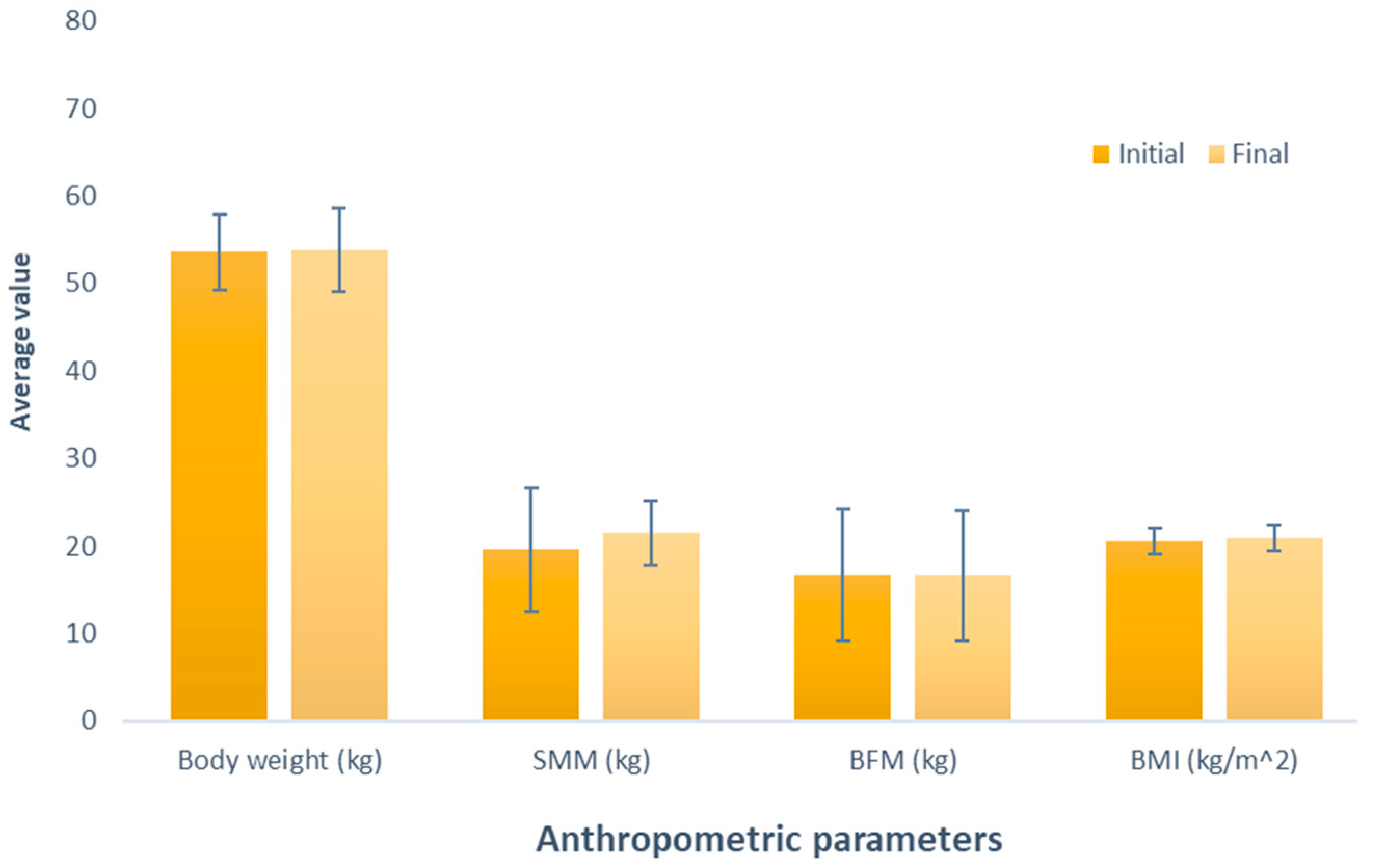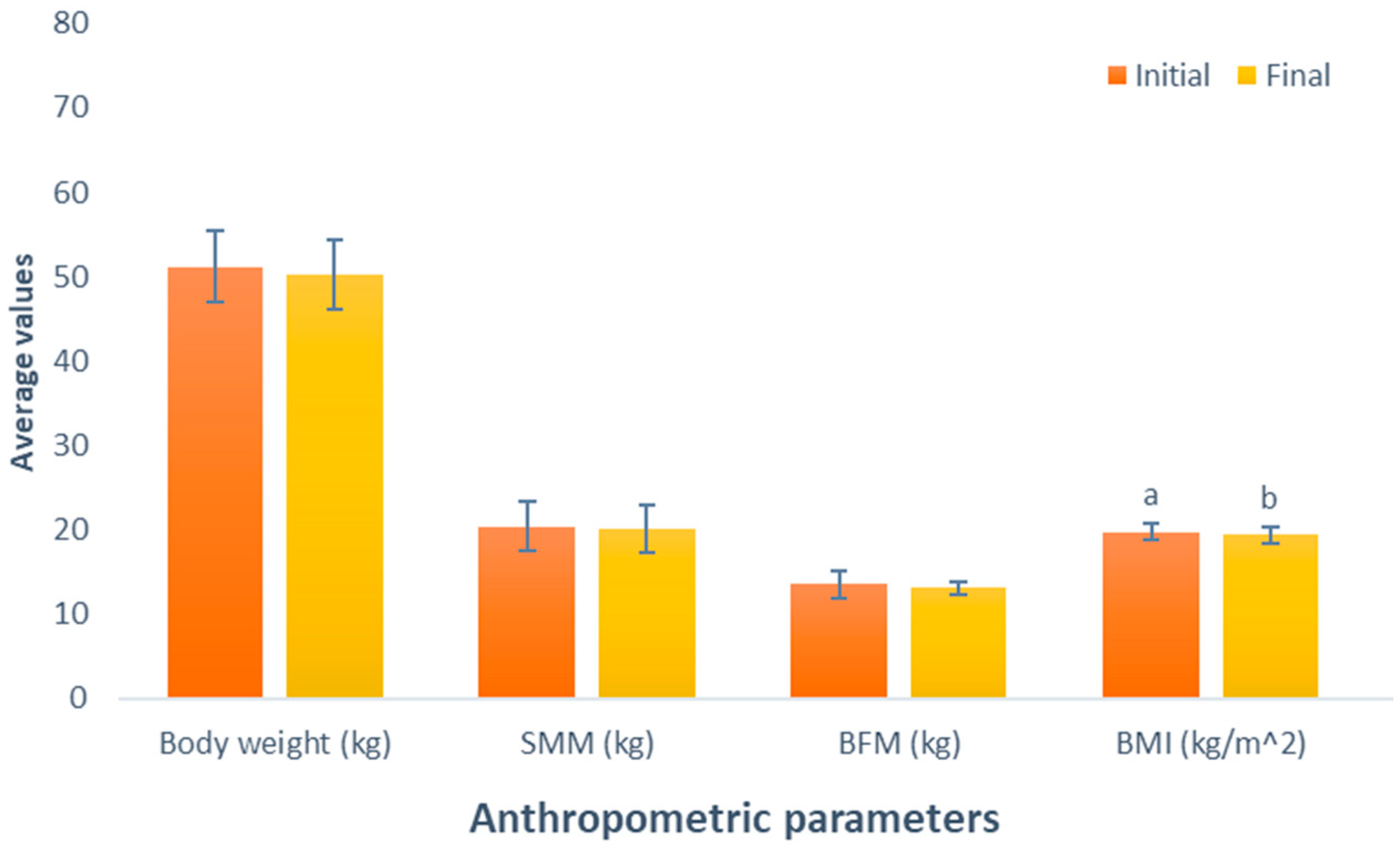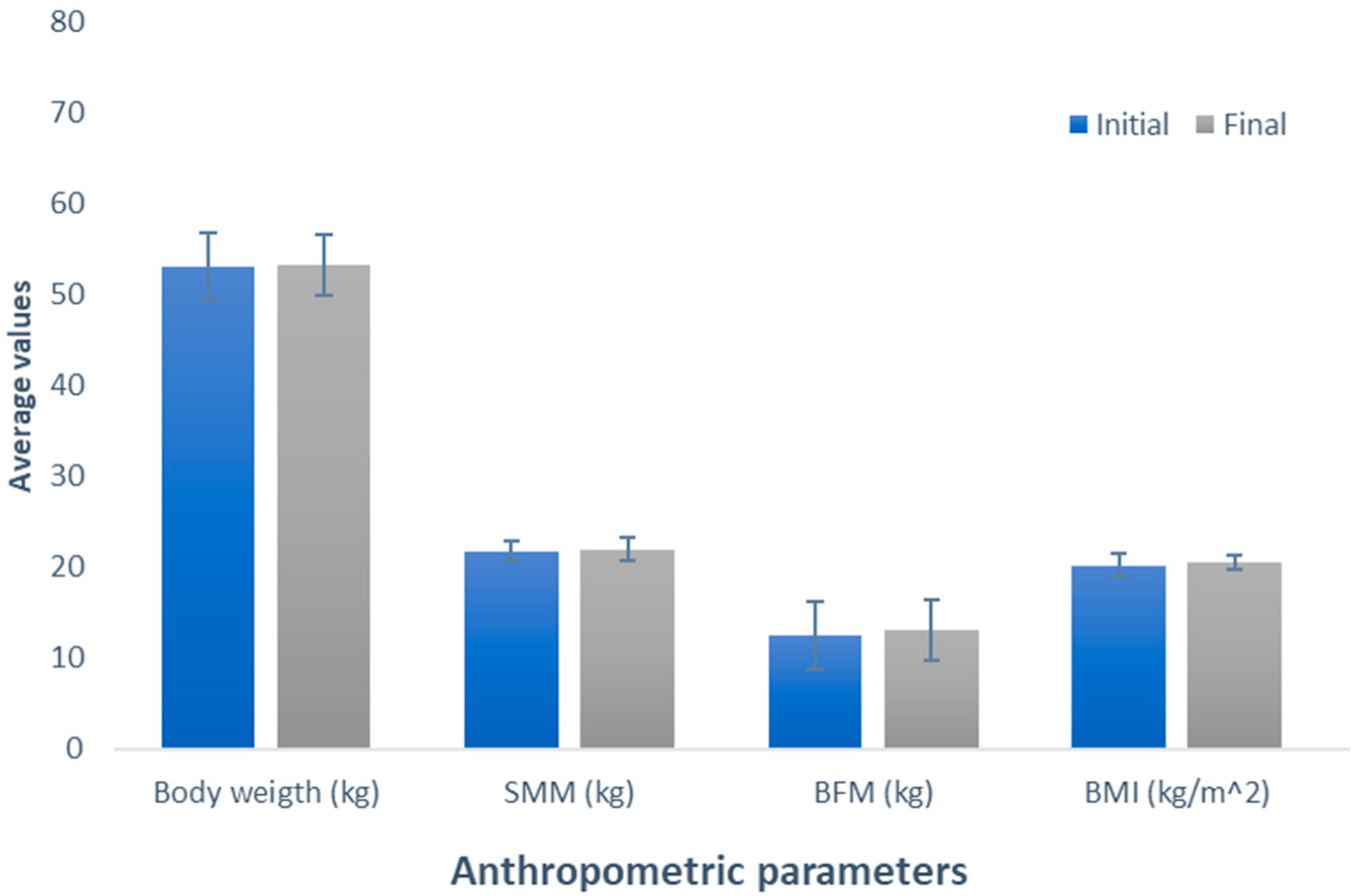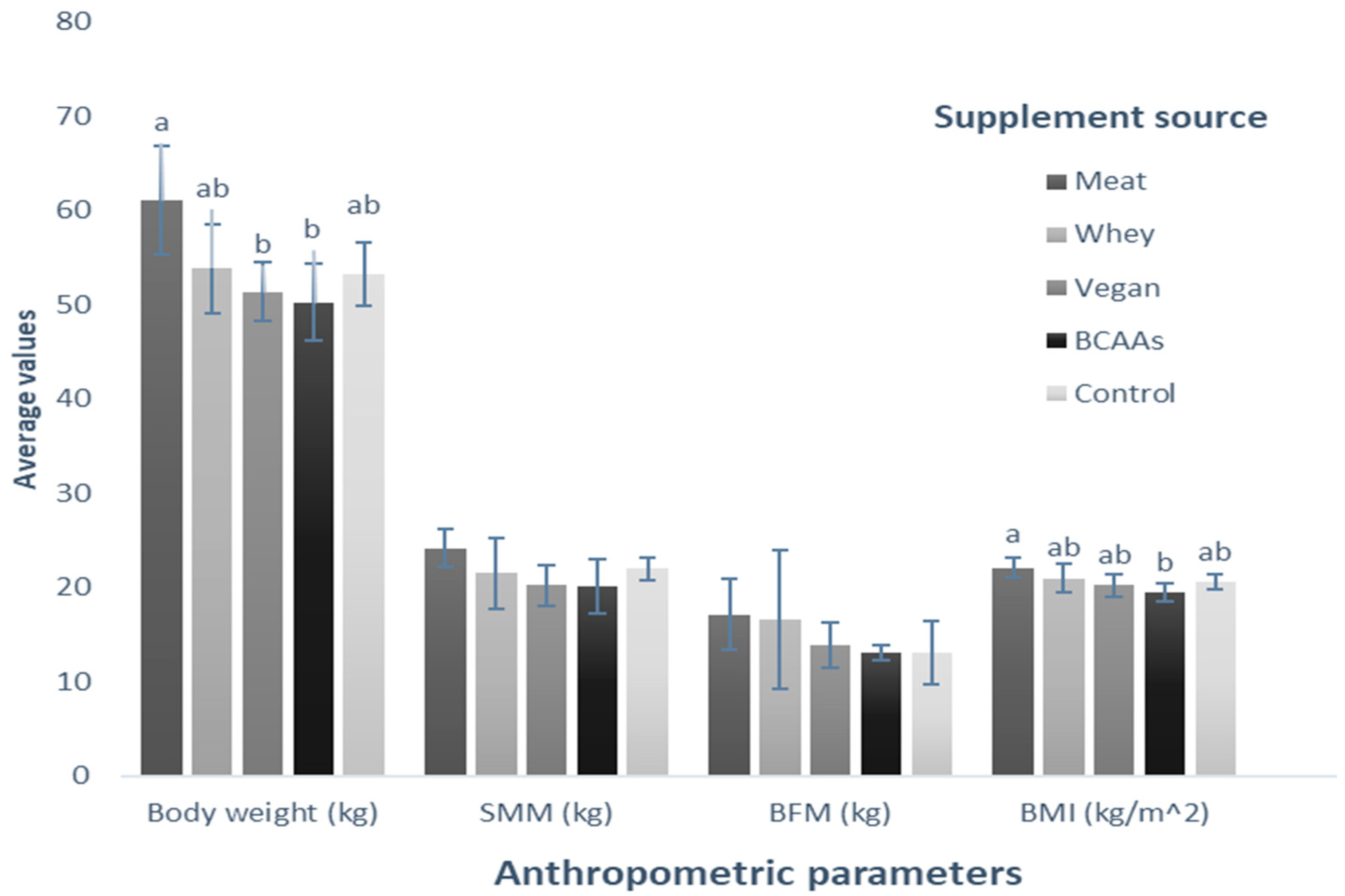Exploring the Impact of Protein Supplement Source on Body Composition in Women Practicing Anaerobic Resistance Exercise: A Pilot Study
Abstract
1. Introduction
2. Materials and Methods
2.1. Selection of Participants
2.2. Eating Meal Plan Design
2.3. Anaerobic Resistance Routine
2.4. Anthropometric Evaluations
2.5. Statistical Analysis
3. Results
3.1. Eating Meal Plan and Supplementation
3.2. Body Composition Effects of Protein Supplementation on the Participants
4. Discussion
5. Study Limitations
6. Conclusions
Author Contributions
Funding
Institutional Review Board Statement
Informed Consent Statement
Data Availability Statement
Acknowledgments
Conflicts of Interest
References
- Oshita, K.; Myotsuzono, R. An Association between the Physical Activity Level and Skeletal Muscle Mass Index in Female University Students with a Past Exercise Habituation. Osteoporos. Sarcopenia 2021, 7, 146–152. [Google Scholar] [CrossRef] [PubMed]
- Morton, R.W.; Murphy, K.T.; McKellar, S.R.; Schoenfeld, B.J.; Henselmans, M.; Helms, E.; Aragon, A.A.; Devries, M.C.; Banfield, L.; Krieger, J.W.; et al. A Systematic Review, Meta-Analysis and Meta-Regression of the Effect of Protein Supplementation on Resistance Training-Induced Gains in Muscle Mass and Strength in Healthy Adults. Br. J. Sports Med. 2018, 52, 376–384. [Google Scholar] [CrossRef] [PubMed]
- Cermak, N.M.; Res, P.T.; De Groot, L.C.P.G.M.; Saris, W.H.M.; Van Loon, L.J.C. Protein Supplementation Augments the Adaptive Response of Skeletal Muscle to Resistance-Type Exercise Training: A Meta-Analysis. Am. J. Clin. Nutr. 2012, 96, 1454–1464. [Google Scholar] [CrossRef] [PubMed]
- Devries, M.C.; Phillips, S.M. Supplemental Protein in Support of Muscle Mass and Health: Advantage Whey. J. Food Sci. 2015, 80, A8–A15. [Google Scholar] [CrossRef] [PubMed]
- Valenzuela, P.L.; Mata, F.; Morales, J.S.; Castillo-García, A.; Lucia, A. Does Beef Protein Supplementation Improve Body Composition and Exercise Performance? A Systematic Review and Meta-Analysis of Randomized Controlled Trials. Nutrients 2019, 11, 1429. [Google Scholar] [CrossRef] [PubMed]
- Hsu, T.H.; Chiu, C.C.; Wang, Y.C.; Chen, T.H.; Chen, Y.H.; Lee, Y.P.; Hung, S.W.; Wu, C.P.; Chuang, H.L. Supplementation with Beef Extract Improves Exercise Performance and Reduces Post-Exercise Fatigue Independent of Gut Microbiota. Nutrients 2018, 10, 1740. [Google Scholar] [CrossRef] [PubMed]
- Park, Y.; Park, H.-Y.; Kim, J.; Hwang, H.; Jung, Y.; Kreider, R.; Lim, K. Effects of Whey Protein Supplementation Prior to, and Following, Resistance Exercise on Body Composition and Training Responses: A Randomized Double-Blind Placebo-Controlled Study. J. Exerc. Nutr. Biochem. 2019, 23, 34. [Google Scholar] [CrossRef] [PubMed]
- West, S.; Monteyne, A.J.; Van Der Heijden, I.; Stephens, F.B.; Wall, B.T. Nutritional Considerations for the Vegan Athlete. Adv. Nutr. 2023, 14, 774–795. [Google Scholar] [CrossRef]
- Ramos-Vázquez, A.G.; Reyes-Torres, C.A.; Castillo-Martínez, L.; Serralde-Zúñiga, A.E. Composición Corporal Mediante Impedancia Bioeléctrica, Fuerza Muscular y Riesgo Nutricional En Pacientes Con Disfagia Orofaríngea. Nutr. Hosp. 2021, 38, 315–320. [Google Scholar] [CrossRef]
- NOM-012-SSA3-2012; Que Establece los Criterios para la Ejecución de Proyectos de Investigación para la Salud en Seres Humanos. Diario Oficial de la Federación: Ciudad de México, Mexico, 2012.
- WHO. A Healthy Lifestyle—WHO Recommendations. Available online: https://www.who.int/europe/news-room/fact-sheets/item/a-healthy-lifestyle---who-recommendations (accessed on 7 November 2023).
- NOM-004-SSA3-2012; Del Expediente Clínico. Secretaría de Salud, Diario Oficial de la Federación: Ciudad de México: Acapulco, Mexico, 2012.
- Troncoso-Pantoja, C.; Alarcón-Riveros, M.; Amaya-Placencia, J.; Sotomayor-Castro, M.; Maury-Sintjago, E.; Troncoso-Pantoja, C.; Alarcón-Riveros, M.; Amaya-Placencia, J.; Sotomayor-Castro, M.; Maury-Sintjago, E. Guía Práctica de Aplicación Del Método Dietético Para El Diagnóstico Nutricional Integrado. Rev. Chil. Nutr. 2020, 47, 493–502. [Google Scholar] [CrossRef]
- Hernández-Ortega, A.; Osuna-Padilla, I.A.; Rendón-Rodríguez, R.; Narváez-Velázquez, B.; Chávez-González, M.J.; Estrada-Velasco, B. Exactitud de Las Ecuaciones Predictivas Del Gasto Energético Basal: Estudio Transversal En Niños y Adolescentes Con Sobrepeso y Obesidad de Morelos, México. Rev. Española Nutr. Humana Dietética 2019, 23, 83–91. [Google Scholar] [CrossRef]
- Ascencio Peralta, C. Elementos Fundamentales En El Cálculo de Dietas, 2nd ed.; Manual Moderno: Ciudad de México, Mexico, 2017. [Google Scholar]
- American College of Sports Medicine. Protein Intake for Optimal Muscle Maintenance; American College of Sports Medicine: Indianapolis, IN, USA, 2015. [Google Scholar]
- Vázquez, C.; Escalante, A.; Huerta, J.; Villarreal, M.E.; Vázquez, C.; Escalante, A.; Huerta, J.; Villarreal, M.E. Efectos de La Frecuencia de Consumo de Alimentos Ultraprocesados y Su Asociación Con Los Indicadores Del Estado Nutricional de Una Población Económicamente Activa En México. Rev. Chil. Nutr. 2021, 48, 852–861. [Google Scholar] [CrossRef]
- Yoshimura, Y.; Bise, T.; Shimazu, S.; Tanoue, M.; Tomioka, Y.; Araki, M.; Nishino, T.; Kuzuhara, A.; Takatsuki, F. Effects of a Leucine-Enriched Amino Acid Supplement on Muscle Mass, Muscle Strength, and Physical Function in Post-Stroke Patients with Sarcopenia: A Randomized Controlled Trial. Nutrition 2019, 58, 1–6. [Google Scholar] [CrossRef] [PubMed]
- Karpińska, E.; Moskwa, J.; Puścion-Jakubik, A.; Naliwajko, S.K.; Soroczyńska, J.; Markiewicz-Żukowska, R.; Socha, K. Body Composition of Young Women and the Consumption of Selected Nutrients. Nutrients 2022, 15, 129. [Google Scholar] [CrossRef]
- Fosbøl, M.Ø.; Zerahn, B.; Fosbøl, M.Ø. Contemporary Methods of Body Composition Measurement Summary Correspondence. Clin. Physiol. Funct. Imaging 2015, 35, 81–97. [Google Scholar] [CrossRef]
- Bes-Rastrollo, M.; Sánchez-Villegas, A.; Gómez-Gracia, E.; Martínez, J.A.; Pajares, R.M.; Martínez-González, M.A. Predictors of Weight Gain in a Mediterranean Cohort: The Seguimiento Universidad de Navarra Study. Am. J. Clin. Nutr. 2006, 83, 362–370. [Google Scholar] [CrossRef]
- López-Luzardo, M. Las Dietas Hiperproteicas y Sus Consecuencias Metabólicas. An. Venez. Nutr. 2009, 22, 95–104. [Google Scholar]
- Daly, R.M.; O’Connell, S.L.; Mundell, N.L.; Grimes, C.A.; Dunstan, D.W.; Nowson, C.A. Protein-Enriched Diet, with the Use of Lean Red Meat, Combined with Progressive Resistance Training Enhances Lean Tissue Mass and Muscle Strength and Reduces Circulating IL-6 Concentrations in Elderly Women: A Cluster Randomized Controlled Trial. Am. J. Clin. Nutr. 2014, 99, 899–910. [Google Scholar] [CrossRef]
- Lynch, H.M.; Buman, M.P.; Dickinson, J.M.; Ransdell, L.B.; Johnston, C.S.; Wharton, C.M. No Significant Differences in Muscle Growth and Strength Development When Consuming Soy and Whey Protein Supplements Matched for Leucine Following a 12 Week Resistance Training Program in Men and Women: A Randomized Trial. Int. J. Environ. Res. Public Health 2020, 17, 3871. [Google Scholar] [CrossRef]
- Brooks Mobley, C.; Haun, C.T.; Roberson, P.A.; Mumford, P.W.; Romero, M.A.; Kephart, W.C.; Anderson, R.G.; Vann, C.G.; Osburn, S.C.; Pledge, C.D.; et al. Effects of Whey, Soy or Leucine Supplementation with 12 Weeks of Resistance Training on Strength, Body Composition, and Skeletal Muscle and Adipose Tissue Histological Attributes in College-Aged Males. Nutrients 2017, 9, 972. [Google Scholar] [CrossRef]
- Nabuco, H.C.G.; Tomeleri, C.M.; Sugihara Junior, P.; Fernandes, R.R.; Cavalcante, E.F.; Antunes, M.; Ribeiro, A.S.; Teixeira, D.C.; Silva, A.M.; Sardinha, L.B.; et al. Effects of Whey Protein Supplementation Pre- or Post-Resistance Training on Muscle Mass, Muscular Strength, and Functional Capacity in Pre-Conditioned Older Women: A Randomized Clinical Trial. Nutrients 2018, 10, 563. [Google Scholar] [CrossRef]
- Martínez Augustón, O.; Martínez de Victoria Muñoz, E. Proteínas y Péptidos En Nutrición Enteral. Nutr. Hosp. 2006, 21, 1–14. [Google Scholar]
- Gilani, G.S.; Xiao, C.W.; Cockell, K.A. Impact of Antinutritional Factors in Food Proteins on the Digestibility of Protein and the Bioavailability of Amino Acids and on Protein Quality. Br. J. Nutr. 2012, 108, S315–S332. [Google Scholar] [CrossRef]
- Mathai, J.K.; Liu, Y.; Stein, H.H. Values for Digestible Indispensable Amino Acid Scores (DIAAS) for Some Dairy and Plant Proteins May Better Describe Protein Quality than Values Calculated Using the Concept for Protein Digestibility-Corrected Amino Acid Scores (PDCAAS). Br. J. Nutr. 2017, 117, 490–499. [Google Scholar] [CrossRef]
- Banaszek, A.; Townsend, J.R.; Bender, D.; Vantrease, W.C.; Marshall, A.C.; Johnson, K.D. The Effects of Whey vs. Pea Protein on Physical Adaptations Following 8-Weeks of High-Intensity Functional Training (HIFT): A Pilot Study. Sports 2019, 7, 12. [Google Scholar] [CrossRef]
- Hevia-Larraín, V.; Gualano, B.; Longobardi, I.; Gil, S.; Fernandes, A.L.; Costa, L.A.R.; Pereira, R.M.R.; Artioli, G.G.; Phillips, S.M.; Roschel, H. High-Protein Plant-Based Diet Versus a Protein-Matched Omnivorous Diet to Support Resistance Training Adaptations: A Comparison Between Habitual Vegans and Omnivores. Sports Med. 2021, 51, 1317–1330. [Google Scholar] [CrossRef]
- Stout, J.R.; Smith, A.E.; Kendall, K.L.; Fukuda, D.H. Efecto Del Consumo Pre-Entrenamiento de Un Suplemento de Cafeína, Creatina y Aminoácidos, Junto Con Tres Semanas de Ejercicio de Alta-Intensidad Sobre El Rendimiento Aeróbico y Anaeróbico. Publice 2010, 1–15. Available online: https://g-se.com/efecto-del-consumo-pre-entrenamiento-de-un-suplemento-de-cafeina-creatina-y-aminoacidos-junto-con-tres-semanas-de-ejercicio-de-alta-intensidad-sobre-el-rendimiento-aerobico-y-anaerobico-1332-sa-B57cfb271f2d61 (accessed on 7 November 2023).
- Blomstrand, E.; Saltin, B. BCAA Intake Affects Protein Metabolism in Muscle after but Not during Exercise in Humans. Am. J. Physiol.-Endocrinol. Metab. 2001, 281, E365–E374. [Google Scholar] [CrossRef]
- Vandusseldorp, T.A.; Escobar, K.A.; Johnson, K.E.; Stratton, M.T.; Moriarty, T.; Cole, N.; McCormick, J.J.; Kerksick, C.M.; Vaughan, R.A.; Dokladny, K.; et al. Effect of Branched-Chain Amino Acid Supplementation on Recovery Following Acute Eccentric Exercise. Nutrients 2018, 10, 1389. [Google Scholar] [CrossRef]
- González-Garrido, J.A.; García-Sánchez, J.R.; Garrido-Llanos, S.; Olivares-Corichi, I.M. An Association of Cocoa Consumption with Improved Physical Fitness and Decreased Muscle Damage and Oxidative Stress in Athletes. J. Sports Med. Phys. Fit. 2017, 57, 441–447. [Google Scholar] [CrossRef]
- Jonvik, K.L.; Paulussen, K.J.M.; Danen, S.L.; Ceelen, I.J.M.; Horstman, A.M.; Wardenaar, F.C.; Van Loon, L.U.C.J.C.; Van Dijk, J.W. Protein Supplementation Does Not Augment Adaptations to Endurance Exercise Training. Med. Sci. Sports Exerc. 2019, 51, 2041–2049. [Google Scholar] [CrossRef]
- Kritikos, S.; Papanikolaou, K.; Draganidis, D.; Poulios, A.; Georgakouli, K.; Tsimeas, P.; Tzatzakis, T.; Batsilas, D.; Batrakoulis, A.; Deli, C.K.; et al. Effect of Whey vs. Soy Protein Supplementation on Recovery Kinetics Following Speed Endurance Training in Competitive Male Soccer Players: A Randomized Controlled Trial. J. Int. Soc. Sports Nutr. 2021, 18, 23. [Google Scholar] [CrossRef]
- Tapia López, A. Leche Con Cacao: Bebida Deportiva Para Deportes de Resistencia. Rev. Española Educ. Física Deportes-REEFD 2017, 419, 37–53. [Google Scholar] [CrossRef]
- Valenzuela, P.L.; Morales, J.S.; Emanuele, E.; Pareja-Galeano, H.; Lucia, A. Supplements with Purported Effects on Muscle Mass and Strength. Eur. J. Nutr. 2019, 58, 2983–3008. [Google Scholar] [CrossRef]
- Valenzuela, P.L.; Montalvo, Z.; Mata, F.; González, M.; Larumbe-Zabala, E.; Naclerio, F. Effects of Beef Protein Supplementation in Male Elite Triathletes: A Randomized, Controlled, Double-Blind, Cross-Over Study. J. Am. Coll. Nutr. 2021, 40, 53–60. [Google Scholar] [CrossRef]
- Naclerio, F.; Seijo, M.; Larumbe-Zabala, E.; Ashrafi, N.; Christides, T.; Karsten, B.; Nielsen, B.V. Effects of Supplementation with Beef or Whey Protein Versus Carbohydrate in Master Triathletes. J. Am. Coll. Nutr. 2017, 36, 593–601. [Google Scholar] [CrossRef]
- Tang, J.E.; Moore, D.R.; Kujbida, G.W.; Tarnopolsky, M.A.; Phillips, S.M. Ingestion of Whey Hydrolysate, Casein, or Soy Protein Isolate: Effects on Mixed Muscle Protein Synthesis at Rest and Following Resistance Exercise in Young Men. J. Appl. Physiol. 2009, 107, 987–992. [Google Scholar] [CrossRef]
- Putra, C.; Konow, N.; Gage, M.; York, C.G.; Mangano, K.M. Protein Source and Muscle Health in Older Adults: A Literature Review. Nutrients 2021, 13, 743. [Google Scholar] [CrossRef]
- Kerksick, C.M.; Jagim, A.; Hagele, A.; Jäger, R. Plant Proteins and Exercise: What Role Can Plant Proteins Have in Promoting Adaptations to Exercise? Nutrients 2021, 13, 1962. [Google Scholar] [CrossRef]
- Roelofs, E.J.; Smith-Ryan, A.E. Effects Of Branched-Chain Amino Acids On Resting Metabolic Rate, Body Composition, And Satiety In Females. Med. Sci. Sports Exerc. 2017, 49, 81. [Google Scholar] [CrossRef]






| Group/Protein Source | Age (Years) | Height (cm) | Body Weight (kg) | SMM (kg) | BFM (kg) | BMI (kg/m2) |
|---|---|---|---|---|---|---|
| 1. Whey protein | 19.5 (1.29) a | 160.25 (2.22) a | 53.56 (4.30) ab | 19.44 (7.0) a | 16.64 (7.55) a | 20.50 (1.49) a |
| 2. Vegan | 21.6 (2.30) a | 158.40 (3.05) a | 54.08 (4.48) ab | 21.56 (3.49) a | 14.10 (3.04) a | 21.22 (1.11) a |
| 3. Meat | 22.25 (1.50) a | 161.0 (2.94) a | 60.78 (6.34) a | 23.44 (1.92) a | 17.86 (5.29) a | 21.96 (1.21) a |
| 4. BCAAs | 22.0 (2.45) a | 159.75 (5.85) a | 51.20 (4.22) b | 20.40 (2.99) a | 13.52 (1.58) a | 19.76 (0.98) a |
| 5. Control | 20.80 (2.68) a | 163.60 (2.22) a | 53.06 (3.67) ab | 21.78 (1.08) a | 12.48 (3.68) a | 20.24 (1.23) a |
| Group | Carbohydrates (g) | Proteins (g) | Lipids (g) | Total Energy (kcal) |
|---|---|---|---|---|
| 1 | 112.5 (47.4) a | 53.50 (20.43) ab | 37.50 (15.29) ab | 879.2 (205.9) ab |
| 2 | 97.7 (29.2) a | 36.03 (7.77) ab | 36.92 (23.77) ab | 756.7 (179.7) ab |
| 3 | 128.1 (25.2) a | 64.27 (22.66) ab | 29.78 (5.57) ab | 988.2 (110.1) a |
| 4 | 113.50 (16.90) a | 71.3 (24) a | 39.68 (15.17) a | 1081.2 (152.2) a |
| 5 | 86.4 (65.6) a | 31.6 (24.4) b | 10.32 (10.57) b | 510 (353) b |
| Group | BEE (kcal) | TEF (kcal) | PA (kcal) | TEI (kcal) |
|---|---|---|---|---|
| 1 | 1386 (58.8) a | 138.6 (5.88) a | 138.6 (5.88) a | 1663.2 (70.5) a |
| 2 | 1337.6 (44.1) a | 133.76 (4.41) a | 133.76 (4.41) a | 1605.1 (53) a |
| 3 | 1370.7 (51.1) a | 137.07 (5.11) a | 137.07 (5.11) a | 1644.8 (61.3) a |
| 4 | 1324.7 (43.2) a | 132.55 (4.47) a | 132.55 (4.47) a | 1589.8 (52.2) a |
| 5 | 1382.7 (48) a | 138.27 (4.80) a | 138.27 (4.80) a | 1659.2 (57.6) a |
Disclaimer/Publisher’s Note: The statements, opinions and data contained in all publications are solely those of the individual author(s) and contributor(s) and not of MDPI and/or the editor(s). MDPI and/or the editor(s) disclaim responsibility for any injury to people or property resulting from any ideas, methods, instructions or products referred to in the content. |
© 2024 by the authors. Licensee MDPI, Basel, Switzerland. This article is an open access article distributed under the terms and conditions of the Creative Commons Attribution (CC BY) license (https://creativecommons.org/licenses/by/4.0/).
Share and Cite
Ballesteros-Torres, J.M.; Escalante-Aburto, A.; Villarreal-Arce, M.E.; Caballero-Prado, C.J. Exploring the Impact of Protein Supplement Source on Body Composition in Women Practicing Anaerobic Resistance Exercise: A Pilot Study. Nutrients 2024, 16, 321. https://doi.org/10.3390/nu16020321
Ballesteros-Torres JM, Escalante-Aburto A, Villarreal-Arce ME, Caballero-Prado CJ. Exploring the Impact of Protein Supplement Source on Body Composition in Women Practicing Anaerobic Resistance Exercise: A Pilot Study. Nutrients. 2024; 16(2):321. https://doi.org/10.3390/nu16020321
Chicago/Turabian StyleBallesteros-Torres, Juan Manuel, Anayansi Escalante-Aburto, María Elena Villarreal-Arce, and Cindy Joanna Caballero-Prado. 2024. "Exploring the Impact of Protein Supplement Source on Body Composition in Women Practicing Anaerobic Resistance Exercise: A Pilot Study" Nutrients 16, no. 2: 321. https://doi.org/10.3390/nu16020321
APA StyleBallesteros-Torres, J. M., Escalante-Aburto, A., Villarreal-Arce, M. E., & Caballero-Prado, C. J. (2024). Exploring the Impact of Protein Supplement Source on Body Composition in Women Practicing Anaerobic Resistance Exercise: A Pilot Study. Nutrients, 16(2), 321. https://doi.org/10.3390/nu16020321







